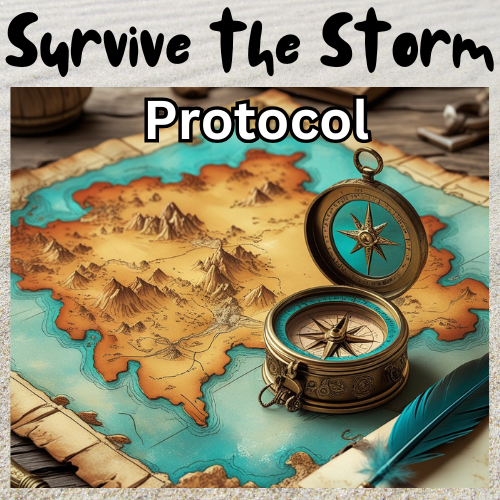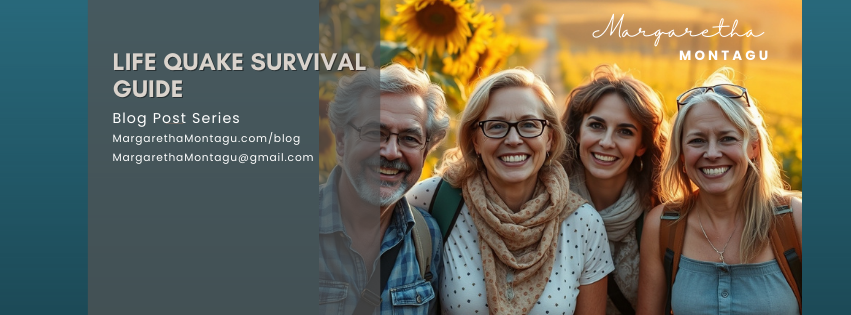The secret to staying calm when everything else is falling apart.
Let’s be brutally honest: the world right now feels like someone handed the steering wheel to a caffeinated squirrel. Political tension? Check. Economic turmoil? Double check. Environmental disasters, AI meltdowns, conspiracy theories, inflation, deflation, and occasional sightings of logic-defying headlines? Oh, we’re swimming in it.
And amidst all of this chaos, someone (probably clutching a turmeric latte and wearing linen) is going to chirp, “You just need to find your inner peace.” Which makes you want to gently (or not so gently) launch said latte into orbit.
But here’s the twist: they’re not entirely wrong. The challenge isn’t in denying the madness of the world—because, let’s face it, madness is the current currency. The challenge is learning how to remain calm in spite of it. Becoming the calm center of your own personal cyclone. The eye of the storm.
And, believe it or not, it’s possible. Not by pretending everything is fine, or chanting mantras while the house burns down, but by cultivating a kind of grounded presence that helps you weather the mess. Inner peace isn’t about ignoring reality—it’s about refusing to let it hijack your nervous system.
So let’s talk about how to be serene without being a saint, wise without being woo-woo, and solid even when the ground is shifting beneath your feet.
First, Let’s Acknowledge the Madness
Before we go all zen-master, let’s be real about something: the world is genuinely scary right now. Whether you’re worried about your savings, your sanity, or just finding toilet paper at a reasonable price, you’re not overreacting. You’re responding like a human with a brain wired for survival.
Our nervous systems weren’t built for 24/7 doomscrolling. They were built for quick sprints from saber-toothed tigers—not enduring a constant barrage of “breaking news” and decisions about whether you should be investing in gold bars or canned beans.
The good news? Once we understand what’s happening in our minds and bodies, we can actually do something about it.
The Science of Stillness: What Neuroscience Says
When chaos hits, your amygdala—the brain’s fear centre—lights up like a Christmas tree. It triggers your fight-flight-freeze response, and suddenly everything feels urgent, personal, and potentially catastrophic. Your rational brain? Offline. Your inner calm? Running for the hills.
But here’s where it gets fascinating: we can train our brains to override that panic.
Neuroscientific studies show that mindfulness practices—such as breathwork, body scans, and even mindful walking—can calm the amygdala, increase activity in the prefrontal cortex (aka your wise adult brain), and regulate the nervous system.
Even just one minute of deep breathing sends a message to your body that you’re safe, which allows clarity, creativity, and calm to return. It’s not magic—it’s biology. And it’s incredibly empowering.
Borrowing Some Horse Sense
This might sound left-field, but hang with me: horses are masters of staying grounded. They don’t get worked up about inflation or who’s leading the polls. They live in the present moment—fully, unapologetically, and with an unwavering awareness of their environment.
When humans spend time around horses, especially in mindful silence, something shifts. Our breath slows. Our posture softens. Our thoughts stop stampeding. Why? Because horses co-regulate with calm beings, and they expect presence in return.
You don’t need to own a horse to learn from this. But you can practice “horse-like mindfulness”—becoming aware of your body, your breath, your surroundings. Standing still and feeling your feet on the ground. It sounds simple, but it’s wildly effective. We borrow a bit of horse wisdom (minus the hay), a bit of neuroscience, and a whole lot of humour to help you become unshakably grounded, even in the middle of chaos.
In fact, this principle is a big part of my How to Survive a Life Quake course.
The Three Layers of Inner Peace
So how do you actually cultivate peace that lasts longer than a lavender-scented bath bomb? I like to think of it in three layers:
1. Physical Grounding
Your body is your first anchor. If your nervous system is spinning out, go for a walk. Stretch. Splash cold water on your face. Eat something nourishing. Get outside. Hug a tree (yes, really). When your body feels safe, your brain starts to follow suit.
Try this micro-practice:
Take five deep breaths. With each exhale, imagine dropping your awareness a little lower—from your head to your chest, to your belly, down to your feet. Feel yourself land in your body.
2. Mental Clarity
This isn’t about pretending everything’s fine. It’s about giving your overworked brain a break from its catastrophic narratives.
Limit your exposure to the news. Seriously. It’s okay not to refresh your feed every 17 minutes. Curate your inputs—podcasts, articles, people—that nourish rather than drain you.
And when you catch yourself spiraling out of control, ask: Is this helpful? Is this true? Is this mine to carry? If the answer is no, it’s okay to let that thought go. I give you full permission to mentally unsubscribe from anything that feels like a psychic energy vampire.
3. Emotional Resilience
Emotions are natural—but letting them hijack your day is optional. Learn to name what you’re feeling (“I’m anxious,” “I’m angry,” “I’m overwhelmed”) without letting it define you.
You’re not your fear. You’re the space holding the fear. That space is wiser, calmer, and far more powerful than we often give it credit for.
Journaling helps. So does talking with someone who won’t try to fix you—just witness you. (And no, your cat doesn’t count, although they are excellent listeners.)
Community Is a Calm Amplifier
Yes, solitude can be healing. But too much isolation, especially when the world feels unsafe, can send you into a lonely feedback loop of fear.
Surround yourself with people who help you feel more like yourself—not the performative, got-it-all-together version, but the messy, human, deeply loveable version. The friends who’ll text you memes and hold space for your existential spiral. That’s your inner circle. Hold them close.
In my How to Survive a Life Quake course, you’ll find powerful tools and gentle guidance to help you navigate uncertainty with a lot less panic. It’s not therapy, and it’s definitely not a pity party. It’s a self-paced journey designed to give you practical strategies, meaningful rituals, and the kind of perspective shifts that make you exhale and think, “Okay… I’ve got this.”
What the Eye of the Storm Really Feels Like
People think calm means becoming immune to the world. It doesn’t.
Being the eye of the storm isn’t about denial or detachment—it’s about rootedness. You see the chaos. You feel the fear. But you don’t let it carry you away.
Inner peace doesn’t mean your life is perfect. It means you trust yourself to respond with wisdom, even when things get messy. It’s a quiet confidence, a sense that no matter what happens, you’ll find your footing.
And if you wobble? That’s okay. Peace isn’t a static state—it’s a choice. Sometimes, a really stubborn one.
Final Thoughts: Peace Is Your Superpower
In a world addicted to panic, cultivating calm is a revolutionary act.
When you choose to be calm in the eye of the storm, you don’t just protect your own well-being—you become a beacon for others. A reminder that even now, in all this madness, peace can still be found.
And sometimes, it starts with a single breath.
So take one now.
And remember—you’ve got this.
And I’ve got your back.
In a world that feels increasingly unstable — politically, economically, emotionally — what will you do when the rug is pulled out from under you? That’s why I created Survive the Storm — a 7-part online course designed to be a lifeline during a life quake. This is your personal survival toolkit for uncertain times — lovingly crafted and packed with practical tools, emotional support, and soul-nourishing insights to help you stay grounded, resilient, and resourceful when everything around you feels like it’s falling apart. Enrol in How to Survive the Storm Protocol, with or without additional mentoring.


“I am an experienced medical doctor – MBChB, MRCGP, NLP master pract cert, Transformational Life Coach (dip.) Life Story Coach (cert.) Stress Counselling (cert.) Med Hypnotherapy (dip.) and EAGALA (cert.) I may have an impressive number of letters after my name, and more than three decades of professional experience, but what qualifies me to excel at what I do is my intuitive understanding of my clients’ difficulties and my extensive personal experience of managing major life changes using strategies I developed over many years.” Dr M Montagu

